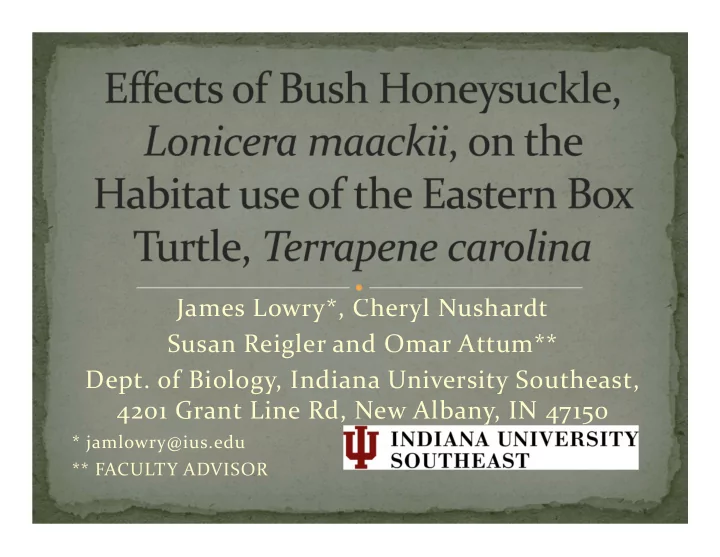

James Lowry*, Cheryl Nushardt Susan Reigler and Omar Attum** Dept. of Biology, Indiana University Southeast, 4201 Grant Line Rd, New Albany, IN 47150 * jamlowry@ius.edu ** FACULTY ADVISOR
Outline Introduction • Conservation of Urban Nature Preserves • Invasive Species – Bush Honeysuckle (BHS) • Box Turtle useful model species Methods • Site Study • Radiotelemetry • Data Collection Results • Relationship of Bush Honeysuckle Density and Turtle Location • Box Turtle use of Artificial Canopy Gaps Management Implications
Conservation value: Last remaining undeveloped habitat in urban area Species of concern People develop appreciation of nature Environmental education Challenges: Habitat Island Vulnerable to invasive species and disturbance Hiking trails Artificial Canopy Gap Avenue for invasive Species to Spread
Invasive Species Bush Honeysuckle ‐ Most common invasive plant species of concern Reduce overall biodiversity of native plant species • Longer growing seasons • Sunlight reduction • Changes soil chemistry
Why Box Turtles? Great model species • Diet • Thermoregulation Species of concern • Hard edge mortality • Habitat Loss • Pet trade
Methods : Study Site – Blackacre State Nature Preserve (Louisville, KY) • Urban forest – secondary growth • Study site size 44 hectacres • Estimated 100, 000 bush honeysuckle • Surrounded by suburban neighborhoods
Methods : Radiotelemetry • 10 box turtles affixed with transmitters
Methods : Turtle data collection Environmental: • Humidity, Air temperature, and ground temperature Microhabitat: • Bush Honeysuckle Density • Leaf litter depth • Distance to nearest tree (DBH = 20cm) • Distance to nearest fallen branch (DBH = 20cm) • Canopy Cover – densitometer
Do box turtles avoid areas with high bush honeysuckle density? Compared bush honeysuckle density of turtle locations vs. random points (Population level) • 110 randomly selected points • Map – GIS: ArcGIS ‐ Spatial Analysis • Logistic regression: Dependent variable (turtle location/random )
Are box turtles more likely to occur in the vicinity of hiking trails Compared distance of turtles to nearest hiking trails vs. randomly selected points • Turtle locations: GIS • Random points : MCP around combined turtle locations, 261 random points within MCP • Logistic regression
Results – Do box turtles avoid areas with high bush honeysuckle density? 0.3 0.25 Density (L. maackii/m2) 0.2 0.15 0.1 0.05 0 Turtle Location Random Figure 1. A comparison of Bush Honeysuckle density (1 L. maackii?/ m 2 ) between turtle locations and random points. • Non ‐ significant trend, χ ² = 2.65, df =1, P = 0.104
Results : Are box turtles more likely to occur in the vicinity of hiking trails 40 35 Distance to Trail (m ) 30 25 20 15 10 5 0 Turtle Location Random Figure 2. A comparison of distance to hiking trail between turtle locations and 261 random points. Significant trend, χ ² = 19.30, df =1, P > 0.001
Box turtles avoid high density of Bush Honeysuckle • Thermoregulation • Lacks nutritional food source • Little to no leaf litter
Box turtles are found near hiking trails Artificial Canopy Openings Thermoregulation •
Management of Urban Nature Preserves Suggest BHS affects habitat use of the eastern box turtle Management suggestions • BHS free zones • Maintain natural canopy gaps • Create artificial gaps
Future Analysis Continued Data Collection • Microhabitat • Season Effects
Summary Introduction • Urban Nature Preserve • Bush Honeysuckle • Box Turtle Methods • Site Study • Radiotelemetry • Data Collection Results • Relationship of Bush Honeysuckle Density and Turtle Location • Proximity to Hiking Trails Management Implications
References Allan, B.H., Dutra, H.P., et al. Invasive honeysuckle eradication reduces tick ‐ borne disease risk by altering host dynamics. PNAS October 26, 2010,vol. 107, no. 43 Attum, .O; Otoum , M. et al. Movement patterns and habitat use of soft ‐ released translocated spur ‐ thighed tortoises, Testudo graeca. European Journal of Wildlife Research August 2010 Bernstein, N., Richtsmeier, R.J. Home Range and Philopatry in the Ornate BoxTurtle, Terrapene ornata ornata, in Iowa The American Midland Naturalist, 157(1):162 ‐ 174. 2007. Boyce, R.L. Invasive Shrubs in Kentucky. Humboldt Field Research Institute Northeastern Naturalist, 17(mo7):1 ‐ 32. 2010. Collier,M.H.; Vankat,J.L.; Hughes, M.R.Diminished Plant Richness and Abundance below Lonicera Maackii, an Invasive Shrub. Source: American Midland Naturalist, Vol. 147, No. 1 (Jan., 2002), pp. 60 ‐ 71 Currylow, A.F.; Zollner, P.A. et al.A Survival Estimate of Midwestern Adult Eastern Box Turtles Using Radiotelemetry. The American Midland Naturalist 165(1):143 ‐ 149. 2011 Flory S.L, and Keith Clay, K.Invasive shrub distribution varies with distance to roads and stand age in eastern deciduous forests in Indiana, USA. Plant Ecology (2006) 184:131 –141 Iglay, R. B., J. L. Bowman, and N. H. Nazdrowicz. 2007. Eastern Box Turtle ( Terrapene carolina carolina ) movements in a fragmented landscape. J. Herpetol 41:102–106. IUCN 2009. 2009 IUCN Red List of threatened species International Union for Conservation of Nature and Natural Resources. Jennings, A.H. Use of Habitats and Microenvironments by Juvenile Florida Box Turtles Terrepene Carolina Bauri , on Egmont Key. Herpetologica, 63(1):1 ‐ 10. 2007. Luken J.O. and Goessling N. 1995. Seedling distribution and potential persistence of the exotic shrub Lonicera maackii in fragmented forests. Am. Midland Nat. 133: 124 –130. Miller K.E. and Gorchov D.L. 2004. The invasive shrub, Lonicera maackii, reduces growth and fecundity of perennial forest herbs. Oecologia 139: 359 –375. Nazdrowicz, N. H., J. L. Bowman, and R. R. Roth. 2008. Population ecology of the eastern box turtle in a fragmented landscape. J. Wildl. Manage 72:745–753. Watling, J.I.: Hickman,C.R., et al. Extracts of the invasive shrub Lonicera maackii increase mortality and alter behavior of amphibian larvae. Oecologia (2011) 165:153–159
Acknowledgements IUS Kentucky State Nature Preserves BlackAcre State Nature Preserve Evin Carter IPFW Bruce Kingsbury IPFW
Recommend
More recommend